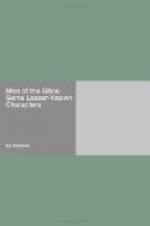seized the sacred money at the Temple and employed
it in building an aqueduct, a piece of utilitarian
profanity which enraged the Jews to such an extent
that a vast crowd gathered, clamouring against Pilate
and insisting on the stoppage of the works.
Then the governor sent soldiers among the people,
disguised in the garb of civilians, who at a given
signal drew their clubs and attacked them more savagely
than Pilate had intended, killing and wounding a great
number. Although Josephus does not mention the
incident recorded by St Luke (xiii. 1), in which Pilate
mingled the blood of some Galilean pilgrims with their
sacrifices, this is entirely in accordance with his
brutality of conduct in the events the historian records.
Philo goes further, giving a story told by Agrippa,
according to which Pilate hung gilt shields in the
palace of Herod at Jerusalem, but was compelled to
take them down as the result of an appeal to Tiberius
Caesar, and adding that Agrippa described Pilate as
“inflexible, merciless, and obstinate.”
He says that Pilate dreaded lest the Jews should
go on an embassy to the emperor, impeaching him for
“his corruptions, his acts of insolence, his
rapine, and his habit of insulting people; his cruelty,
and his continual murders of people untried and uncondemned,
and his never-ending, gratuitous, and most grievous
inhumanity.” Josephus is not trustworthy,
always writing “with a motive,” and Philo
must be considered prejudiced, since he saw too much
of the worst side of the Roman treatment of Jews;
and the wholly unfavourable verdict of these two writers
should be qualified by what we read in the New Testament
concerning the subject of them. The interesting
point is that we have to go to the Christian documents
for the more calm and just estimate of the man who
crucified Christ. This fact should deepen our
sense of the fairness of the evangelists. They
evince nothing of that bitterness of resentment which
the Jews, quite naturally, as the world judges, cherished
towards their oppressors. They were the followers
of One who had taught them to love their enemies,
and who, when in mortal agony, prayed to God to forgive
the men who had inflicted it. But further, the
early Christians discriminated between the Jewish authorities,
who planned and purposed the death of Christ and really
compassed it, and Pilate, who was but a weak instrument
in the hands of these men. The fact that the
evangelists so clearly mark this distinction is a sign
that they are in close touch with the events, and that
they faithfully record what they know to have taken
place. In a word, it is clear that we have a
more just and accurate portrait of Pilate in our Gospels
than the representations of him by Josephus and Philo,
who are thus seen to be less trustworthy historians
than the New Testament writers.




